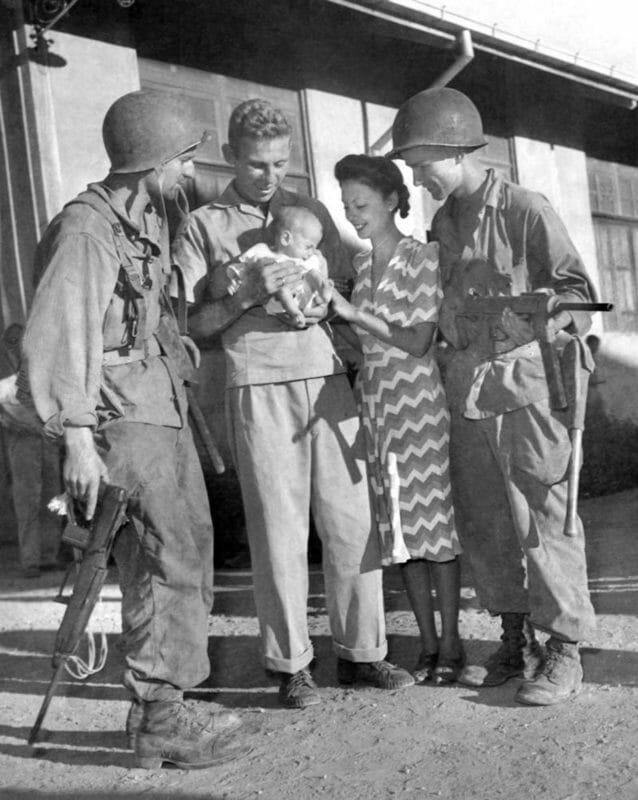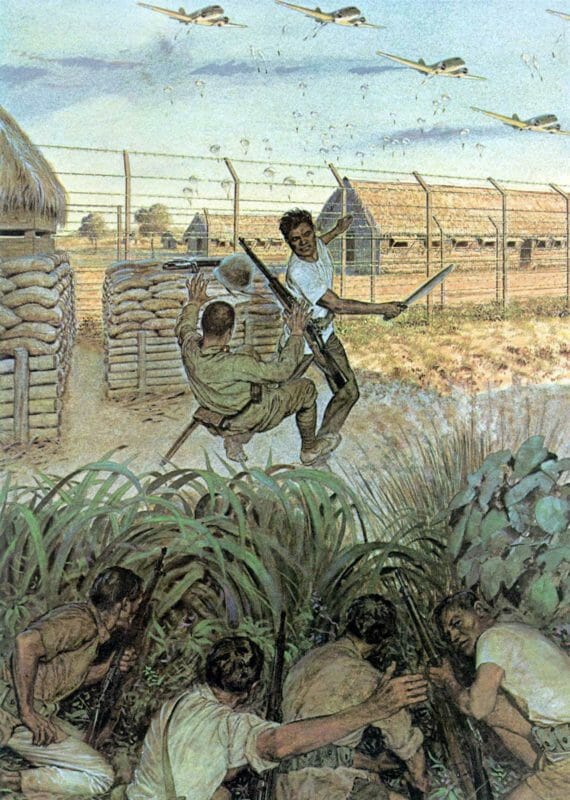Allied liberation of UPLB Japanese prison camp in WWII

Internees with U.S. Airborne troops.
When World War II began in the Philippines on December 8, 1941, a satellite campus of the University of the Philippines, named UP College of Agriculture in Los Baños, was an idyllic academic setting near the shore of Laguna de Bay. Compared with the urban universities in the Metro Manila area, Los Baños was a peaceful retreat from the hectic city lifestyle. The academic curriculum at the college was agriculture and forestry which reflected the rural environment.
The University of the Philippines College of Agriculture was established in 1909. The college was founded by eager, energetic and naive American educators during the early years of American colonialism. The campus was centered around Baker Memorial Hall. The village of Los Baños (meaning bath in English) was named for the hot springs in the area.
In May 1943, the peacefulness of Los Baños was shattered. The Japanese occupation government decided to establish a new Internment or Prison camp at Los Baños for American and Allied civilians. The Santo Tomas Internment Camp (STIC) in Manila was overcrowded, and the Japanese wanted to separate the STIC internees from their Filipino friends outside the camp who secretly provided them with extra provisions and news.
At the time of the Japanese invasion of the Philippines in December 1941, there were over 9,000 American and Allied (mainly American) civilians living in the Philippines. Most of them lived in the Manila area. Some of them had lived in the islands for years, and some were born in the Philippines. The civilians worked in many different occupations, and some of them were business owners. Compared with the average Filipino, they lived very comfortably.

A guerrilla’s rendition of the Allied attack on the UPLB internment camp.
The detainee population at the Santo Tomas Internment Camp had ballooned to over 4,000 since early 1942, and the Japanese were looking for another internment location. The Japanese thought that the UP College of Agriculture was an ideal location since the rural area would sever relationships between Americans and Filipinos and make escape almost impossible in this remote area.
The first group of STIC detainees arrived in Los Baños in May 1943. They were men who were forced to construct barracks on the athletic fields and golf course. They built 26 barracks on 60 acres of campus land. By summer 1944, over 2,000 internees had been transferred from Santo Tomas to UP Los Baños Prison Camp. The number included eleven United States Navy nurses. The nurses had worked at Sternberg General Hospital in Manila and the Navy Hospital at Canacao prior to the war. They were the only military personnel at the camp.
The first two commandants of the prison camp were tolerable. The last commandant was brutal. The Japanese did permit self-rule by the internees including an Executive Committee if Japanese guidelines were followed. Initially, the self-rule in the camp provided many services, but over time services and the amount of food distribution diminished drastically. By early January 1945, most of the prisoners were starving.
By October 1944, the detainees at Los Baños started receiving news of an American return to the islands. There were also reports of significant American advances against the Japanese. Routinely, there were American airplanes flying over the prison camp. This news brought joy and hope to the internees, but it also produced fear. They thought that the Japanese might execute them prior to liberation.
Shortly, the detainees made covert contact with the Filipino guerrillas and American forces for a rescue plan. Once again there was excitement with the developing plan, but there were still fears of a brutal retaliation if the rescue attempt failed. In addition to the human intelligence, the American planners also had aerial intelligence of the prison camp from reconnaissance airplanes.
The target date for the rescue was February 23, 1945. The date was three weeks after the liberation of the Santo Tomas Internment Camp. There were three components of the daring raid. The three were airborne, amphibious and a land raid. The Filipino guerrillas played a significant role in the raid. The amphibious part of the raid included an Amphibian Tractor Battalion and the ubiquitous banca boats. A diversionary attack on near by Japanese forces was part of the plan.
In general, the plan was executed perfectly. Only one internee was wounded. Two soldiers died bravely during the raid, and four soldiers were wounded. The logistical planning was exceptional since it took into consideration that 50 percent of the internees were severely weakened from starvation and disease and would need special evacuation transport.
The one tragic downside to the raid was Japanese retaliation against Filipino civilians. After the raid, the Japanese executed 1,500 innocent people in the village of Los Baños. Unfortunately, Filipino civilians had to endure the brutality of Japanese occupation for over three years. Their sacrifice, hardship and pain must never be forgotten.
Dennis Edward Flake is the author of three books on Philippine-American history. He is Public Historian and a seasonal park ranger in interpretation for the National Park Service at the Eisenhower National Historic Site in Gettysburg, PA. He can be contacted at: flakedennis@gmail.com

